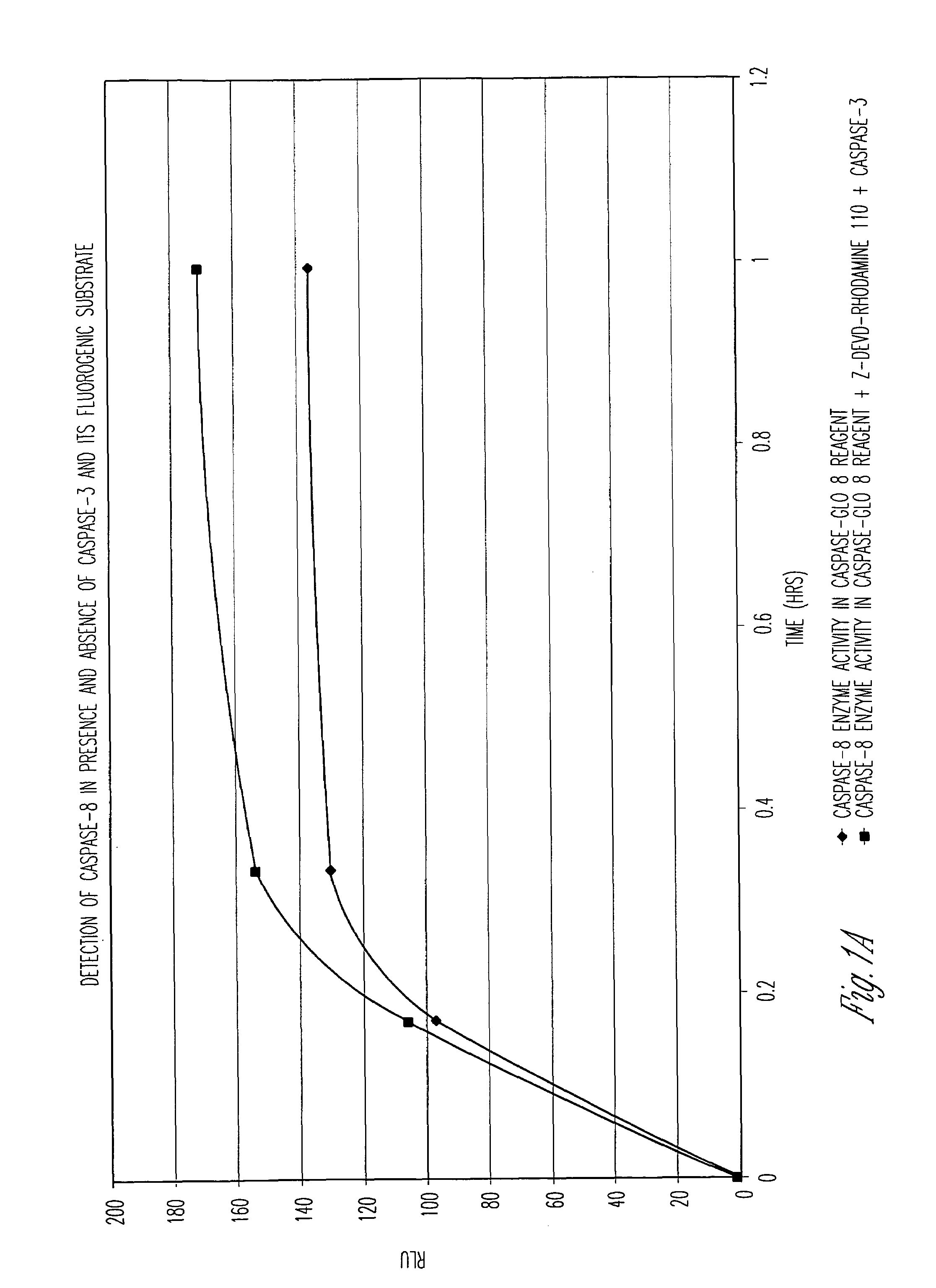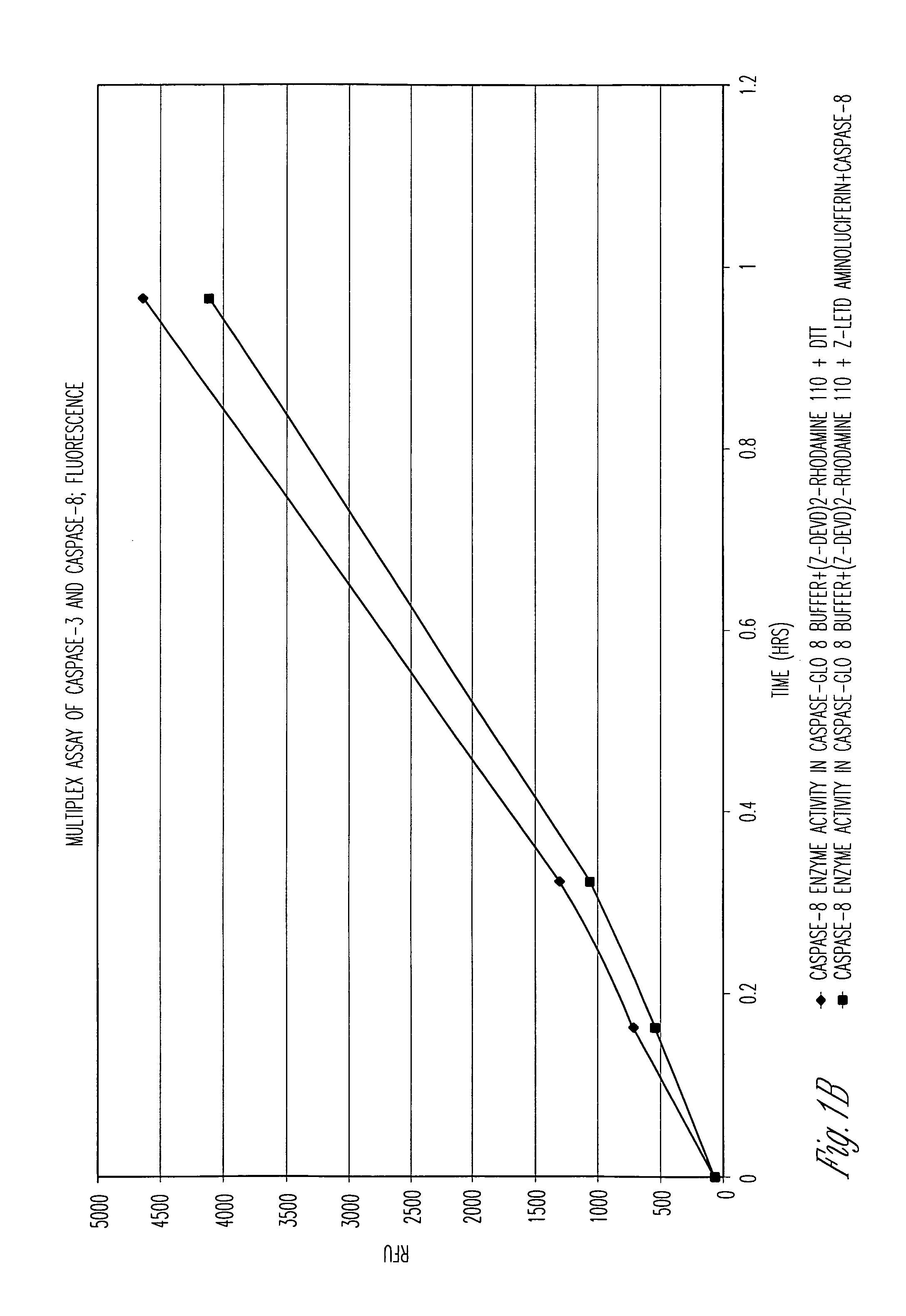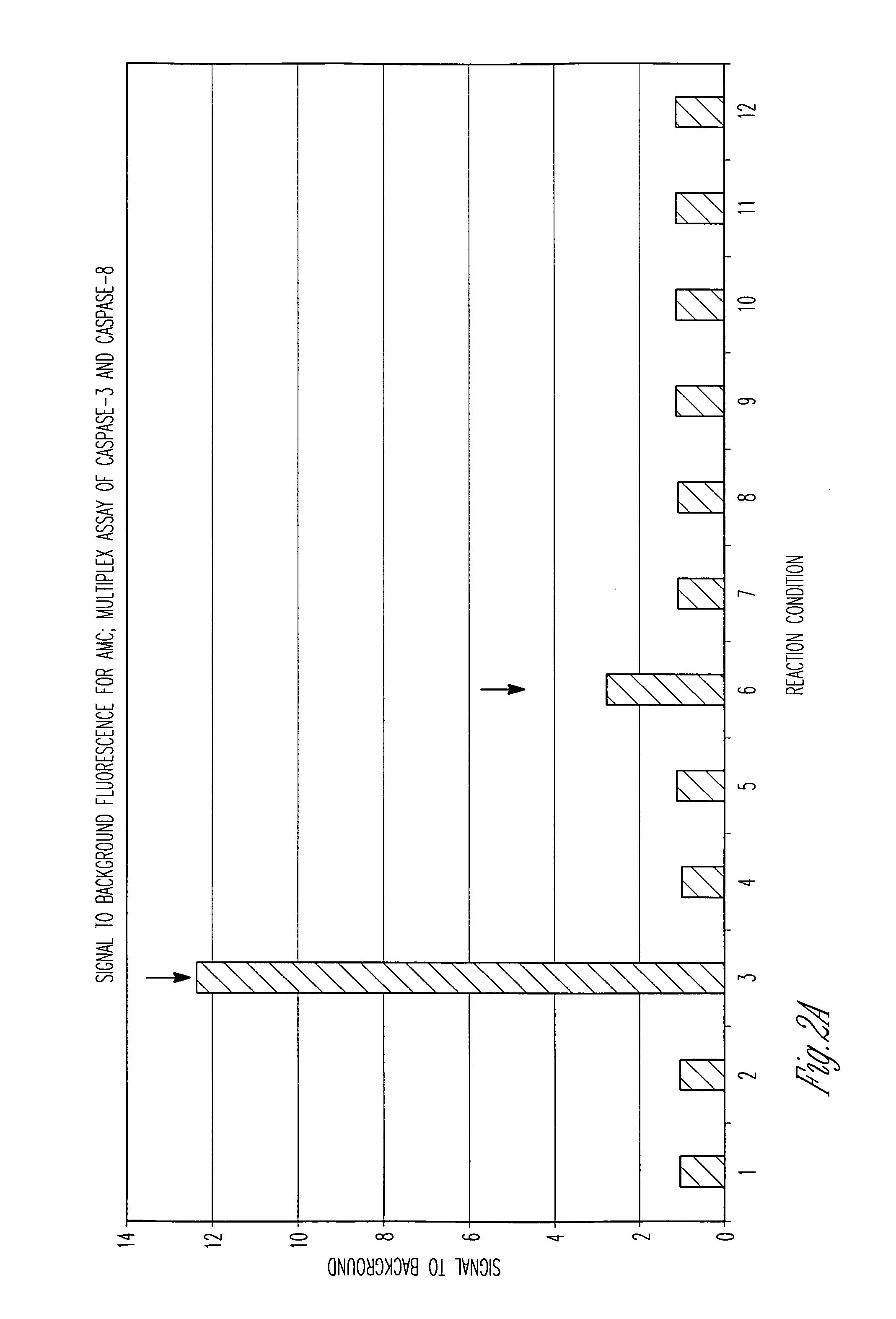Luminogenic and nonluminogenic multiplex assay
a multiplex assay and non-luminogenic technology, applied in the field of multiplex assays, can solve the problems of insensitivity, inability to assay with their naturally occurring substrates, complex combining of two reporter combinations, etc., and achieve the effects of simple assay readout, low cost, and low cos
- Summary
- Abstract
- Description
- Claims
- Application Information
AI Technical Summary
Benefits of technology
Problems solved by technology
Method used
Image
Examples
example i
Fluorescent / Luminescent Multiplex Assays
A. Measurement of Caspase-3 and Caspase-8 in a Single Well, Multiplex Assay
[0107]Caspase-Glo™ 8 Reagent (Caspase-Glo™ 8 Assay System, Promega, Corp.) was evaluated for its ability to allow multiplexing of homogeneous luminogenic caspase-8 and nonluminogenic caspase-3 enzyme assays. Caspase-Glo™ 8 Reagent is comprised of Caspase-Glo™ 8 Buffer and the luminogenic substrate Z-LETD-aminoluciferin (LETD corresponds to SEQ ID NO:14). For the luminogenic assays in FIG. 1A, either Caspase-Glo™ 8 Reagent (diamonds) or Caspase-Glo™ 8 Reagent also containing 50 μM of the fluorogenic substrate for caspase-3, (Z-DEVD)2-rhodamine-110 (squares) (DEVD corresponds to SEQ ID NO:1), was used to demonstrate the feasibility of a multiplexed luminogenic and nonluminogenic assay. For the fluorogenic assay in FIG. 1B, Caspase-Glo™ 8 Buffer containing either 50 μM (Z-DEVD)2-rhodamine-110 (DEVD corresponds to SEQ ID NO:1) and 10 mM DTT (diamonds) or 50 μM (Z-DEVD)2-rho...
example ii
Method to Detect False Results
Methods
[0123]Caspase-Glo™ 3 / 7 Reagent (Caspase-Glo™ 3 / 7 Assay, Promega, Corp.) which contains Z-DEVD-aminoluciferin (DEVD corresponds to SEQ ID NO:1) was combined with (Z-DEVD)2-rhodamine-110 (DEVD corresponds to SEQ ID NO:1) or Ac-DEVD-AMC (DEVD corresponds to SEQ ID NO:1) in the presence of caspase-3 with either a caspase-3 inhibitor (Ac-DEVD-CHO (DEVD corresponds to SEQ ID NO:1), 10 μM) or with a luciferase inhibitor (Resveratol, 5 μM). The luminescent signal from caspase-3 cleavage of Z-DEVD-aminoluciferin (DEVD corresponds to SEQ ID NO:1) was read at 30 minutes, while the fluorescent signals from caspase-3 cleavage activity were read at 2 hours using the appropriate AMC or rhodamine 110 filter sets.
Results
[0124]Luminescence gave the largest signal to background ratio, followed by rhodamine-110, then AMC (FIG. 6). All three substrates for detecting caspase-3 were consistently and negatively impacted by the addition of a known caspase-3 inhibitor. Th...
example iii
Additional Exemplary Multiplex Assays
A. Multiplex Assay For Lactate Dehydrogenase (LDH) and Adenosine Triphosphate (ATP) in a Single Well Format
[0125]The following detection reagents were prepared:1) LDH reagent (30 mM HEPES, pH 7.4, 10 mM NaCl, 20 mM MgSO4, 250 μM resazurin (Aldrich)) was used to reconstitute the lyophilized substrate component from CytoTox-ONE™ Homogeneous Membrane Integrity Assay (Promega Corp, Technical Bulletin 306); 2) ATP reagent (30 mM HEPES pH 7.4, 10 mM NaCl, 20 mM MgSO4) was used to reconstitute the lyophilized substrate from CellTiter-Glo™ Luminescent Cell Viability Assay (Promega Corp, Technical Bulletin 288); 3) LDH / ATP combination reagent (30 mM HEPES pH 7.4, 10 mM NaCl, 20 mM MgSO4, 250 μM resazurin (Aldrich)) was used to reconstitute the lyophilized substrate component from CytoTox-ONE™, which in turn was used to reconstitute the lyophilized substrate from CellTiter-Glo™.
[0126]Sample dilutions of LDH (0, 1:8000, 1:4000, 1:2000, diamonds), ATP (0, 1....
PUM
| Property | Measurement | Unit |
|---|---|---|
| time | aaaaa | aaaaa |
| time | aaaaa | aaaaa |
| time | aaaaa | aaaaa |
Abstract
Description
Claims
Application Information
 Login to View More
Login to View More - R&D
- Intellectual Property
- Life Sciences
- Materials
- Tech Scout
- Unparalleled Data Quality
- Higher Quality Content
- 60% Fewer Hallucinations
Browse by: Latest US Patents, China's latest patents, Technical Efficacy Thesaurus, Application Domain, Technology Topic, Popular Technical Reports.
© 2025 PatSnap. All rights reserved.Legal|Privacy policy|Modern Slavery Act Transparency Statement|Sitemap|About US| Contact US: help@patsnap.com



